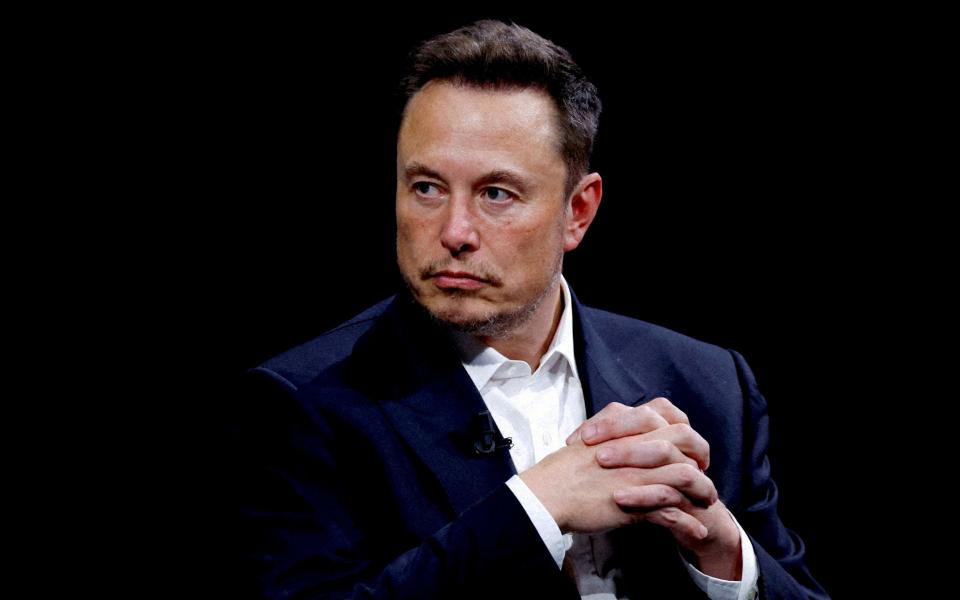Paralysed man with Elon Musk’s Neuralink brain-chip plays video games until battery runs dry
- Oops!Something went wrong.Please try again later.
Paralysed from the shoulders down for eight years, Noland Arbaugh’s brain implant suddenly opened up a world of possibility.
But when the 29-year-old from Arizona became the first person in the world to harness the power of mind control, all he wanted to do was play video games.
Mr Arbaugh is believed to be the first human patient to benefit from ground-breaking neuroscience technology being trialled by Elon Musk’s Neuralink company.
After surgery gave him the power to move a cursor on his computer simply by thinking about it, he logged on to Civilisation VI for eight hours until the implant’s battery ran out of charge.
The medical breakthrough was unveiled in a nine-minute video, in which Mr Arbaugh appears to move a cursor across his laptop’s screen without touching the device or a mouse, that was released by Neuralink on Wednesday.
“See that cursor on the screen? That’s all me ... it’s all brainpower,” said Mr Arbaugh, who lost feeling in his arms and legs after a diving accident around eight years ago.
“I had basically given up playing that game,” he added, referring to Civilization VI, before telling Neuralink staff: “You all gave me the ability to do that again and I played for eight hours straight.”
The video, published on X, also shows him playing chess and turning off the laptop’s music.
Mr Arbaugh, who said he had volunteered for the trial, received the implant in January. “The surgery was super easy,” he added. “I literally was released from the hospital a day later. I have no cognitive impairments.”
‘See that cursor, that’s all me’
“It’s all being done with my brain, if you can see the cursor moving around the screen, that’s all me.” said Mr Arbaugh, who was in a wheelchair and accompanied by a Neuralink employee. He had previously relied on a mouth stick to perform daily tasks.
If the technology is successful and survives rigorous scientific testing, it could revolutionise care for people with disabilities.
In the video, Mr Arbaugh certainly appears satisfied by the potentially life-enhancing effect of the implant, likened moving the mouse around the screen to using “The Force” from the film, Star Wars.
“I’m so freaking lucky to be a part of this, everyday it feels like we’re learning new stuff,’ he said.

Mr Musk announced a month ago that an unnamed person had become the first human to receive the implant.
The billionaire reposted the video of Mr Arbaugh on Wednesday, along with the caption: “Livestream of Neuralink demonstrating ‘Telepathy’ – controlling a computer and playing video games just by thinking.”
Mr Arbaugh, a former student at Texas A&M University, suffered his injury while working at a children’s camp in Texas in 2016. He said he has “absolutely no feeling” from below his shoulders.
Implant ‘has some issues’
Towards the end of the video, he conceded that the implant was “not perfect” and “has run into some issues”.
“I don’t want anyone to think that this is the end of the journey, there’s still a lot of work to be done,” he said. “But it has already changed my life.”
The technology developed by Neuralink uses a robot to surgically place the specially developed implant in a region of the brain that controls body movement.
The system consists of a computer chip attached to tiny flexible threads stitched into the brain by a “sewing-machine-like” robot.
The fitting procedure takes 30 minutes, does not require general anesthesia and creates only a small scar on the scalp.
During the operation, the robot removes a small piece of the skull and connects thread-like electrodes to predetermined areas of the brain.
Scientists who have worked in the field said that Neuralink appeared to have made significant gains but noted that the company’s trial is in its early stages and that not much information had been released publicly.
Responding to the video, Kip Ludwig, former programme director for neural engineering at the US National Institutes of Health, said: “It is still in the very early days post-implantation, and there is a lot of learning, on both the Neuralink side and the subject’s side, to maximise the amount of information for control that can be achieved. It’s certainly a good starting point.”
Neuralink is one of at least three companies that has released evidence of a functioning brain implant.
The company received approval from the US Food and Drug Administration in May for its first human clinical study.

